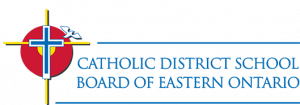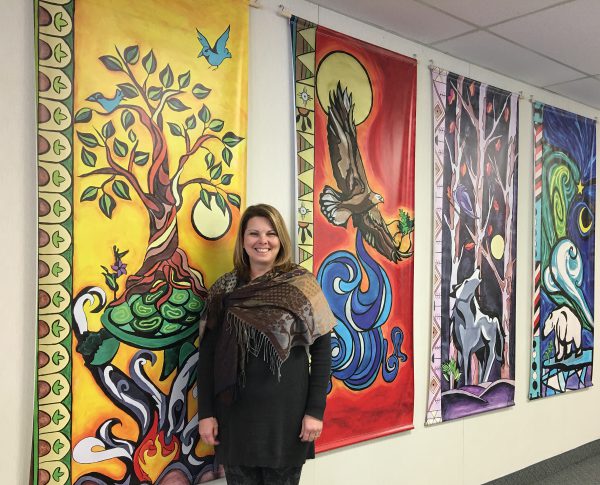CDSBEO Indigenous Education Program Update
Ongoing integration of Indigenous Education remains an integral part of our Board Improvement Plan for Student Achievement. In order to continue the momentum that has been built in Indigenous Education in the CDSBEO, it is important to reflect, to look critically at the work that has been done, and to use data to plan for the future.
Marian Lawson MacDonald, Indigenous Education Lead, presented an update to the Board of Trustees on recent developments and initiatives in the Indigenous Education Program.
“We have been called to action through recommendations set out by the Truth and Reconciliation Commission. In addition, the Ministry of Education has established goals which include: high levels of student achievement, reducing gaps in achievement, and maintaining high levels of public confidence for all students. My role is to look at these same goals through an Indigenous lens,” began Mrs. Lawson MacDonald.
Part of the Ministry mandate is the formation of an Indigenous Education Advisory Committee.
She continued, “CDSBEO has a very proactive, involved committee that advises and guides decision making. Through the collection of data that informs the planning needs of students, the Indigenous Education Advisory Team works in partnership with the Special Education team, and the Board MISA lead.”
“Report card data demonstrating a comparison between average marks of CDSBEO self-identified students versus non-identified students tells us that there is a minimal gap in achievement between the two groups. Provincially, this gap is quite large, so this data is something that we should be very proud of in the CDSBEO,” noted Mrs. Lawson MacDonald.
In order to support struggling students, the Board has established the FNMI Student Support Initiative which provides tutors and targeted supports for Indigenous students based on individual student need.
To further support Indigenous students and cultural learning for non-Indigenous students and staff, the Board has implemented many initiatives since the 2015-2016 school year. All of the initiatives are data driven, and based on educator and student voice, as well as student need. Educator efficacy in Indigenous Education is vital, be it through system wide professional development or professional development in schools.
“Providing authentic information through our community partners is paramount to ensuring that the next generation of youth respect, appreciate and understand First Nation, Métis and Inuit culture, history and perspective,” explained Mrs. Lawson Macdonald.
Two significant events have taken place this year which have helped to strategically carry forward the goals of the Indigenous Education Program. In the fall, CDSBEO gathered for a System Leaders Cultural Sensitivity Day, in collaboration with the Akwesasne Area Management Board, which began at St. Regis Catholic Church in Akwesasne. Faith and educational connections were shared, and Board leaders had the opportunity to learn about the history of the St. Regis Church, and of Saint Kateri Tekakwitha, whose remains are buried at St. Regis.
The CDSBEO Educator and Student Leadership Day was also held on November 8, 2017, providing a launch for both educators, students and system leaders to come together to strengthen a unified approach to planning Indigenous Education in CDSBEO schools. Five students from each of the Board’s secondary schools who are committed to leadership responsibilities in their respective schools also attended. The focus of the day was learning about Indigenous culture, and practical ways of developing and sharing leadership skills.
“Keynote speaker Dr. Sean Lessard, Associate Professor of Education at the University of Alberta and co-founder of the Growing Young Movers Youth Program, shared a message about the importance of building relationships with one another, learning and sharing our stories, and co-creating space in our schools which makes students feel valued,” continued Mrs. Lawson MacDonald. “Dr. Lessard challenged all to find what sustains students, not just what retains them.”
Moving forward the Board will have a balance of initiatives taking place from Kindergarten through to grade 12. These initiatives are the beginning of the integration of Indigenous education curriculum for all subject areas.
“It is exciting to see the growth and success of this program, and the positive response from our school community, who have so enthusiastically embraced learning about Indigenous culture,” indicated Chair Todd Lalonde.
Trustee Sue Wilson noted, “I would like to highlight that we had some very positive feedback from parents regarding the Summer Learning Program, where students were actively involved with the Kokum in the Classroom initiative. It was a very good experience for the students and it is my hope that this part of the Summer Learning Program will continue on.”
Kokum in the Classroom is a CDSBEO initiative which brings Indigenous Grandmothers into the classroom to teach students about authentic Indigenous culture through experiential learning and story-telling. Kokum is a Cree word for a grandmother; they are women who have been acknowledged by their community for their wisdom.
Vice-Chair Ron Eamer expressed his support for the growth of the Indigenous Education program.
“Marian, I would just like to congratulate everyone who is involved in this program. It is amazing to see the learning that is happening for both our students and staff. I am so impressed with the evolution of the program over the years, and how deeply the curriculum and initiatives have evolved to offer rich learning experiences.”
CDSBEO Indigenous Education Lead Marian Lawson MacDonald stands with the Board Indigenous banners, which were created to represent the north, south, east, and west, and distributed to all schools in 2016.

